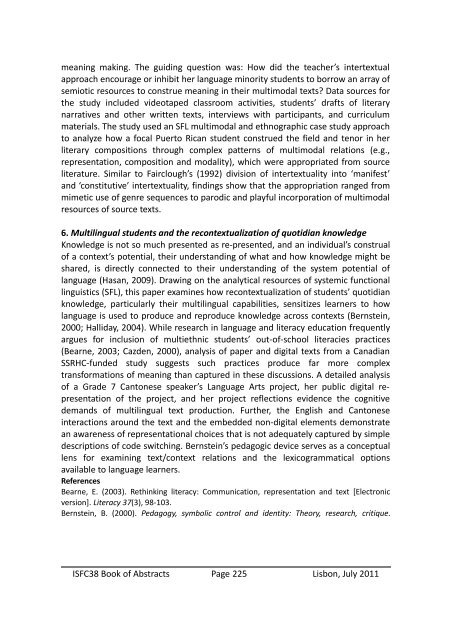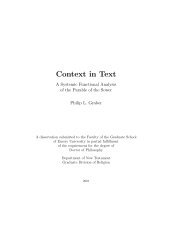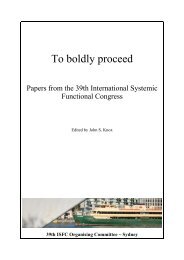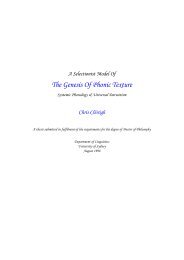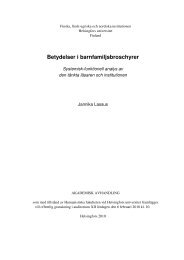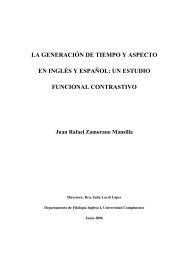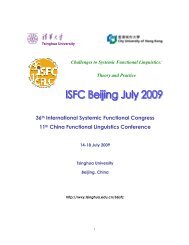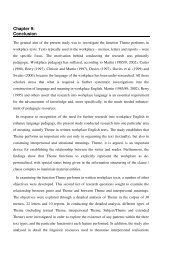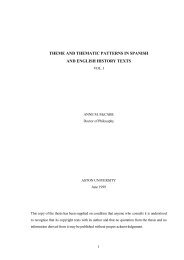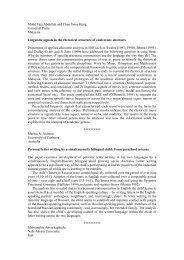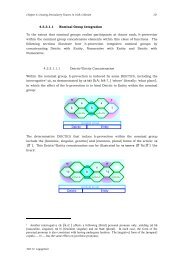Abstracts - Faculdade de Letras da Universidade de Lisboa
Abstracts - Faculdade de Letras da Universidade de Lisboa
Abstracts - Faculdade de Letras da Universidade de Lisboa
- No tags were found...
You also want an ePaper? Increase the reach of your titles
YUMPU automatically turns print PDFs into web optimized ePapers that Google loves.
meaning making. The guiding question was: How did the teacher’s intertextualapproach encourage or inhibit her language minority stu<strong>de</strong>nts to borrow an array ofsemiotic resources to construe meaning in their multimo<strong>da</strong>l texts? Data sources forthe study inclu<strong>de</strong>d vi<strong>de</strong>otaped classroom activities, stu<strong>de</strong>nts’ drafts of literarynarratives and other written texts, interviews with participants, and curriculummaterials. The study used an SFL multimo<strong>da</strong>l and ethnographic case study approachto analyze how a focal Puerto Rican stu<strong>de</strong>nt construed the field and tenor in herliterary compositions through complex patterns of multimo<strong>da</strong>l relations (e.g.,representation, composition and mo<strong>da</strong>lity), which were appropriated from sourceliterature. Similar to Fairclough’s (1992) division of intertextuality into ‘manifest’and ‘constitutive’ intertextuality, findings show that the appropriation ranged frommimetic use of genre sequences to parodic and playful incorporation of multimo<strong>da</strong>lresources of source texts.6. Multilingual stu<strong>de</strong>nts and the recontextualization of quotidian knowledgeKnowledge is not so much presented as re-presented, and an individual’s construalof a context’s potential, their un<strong>de</strong>rstanding of what and how knowledge might beshared, is directly connected to their un<strong>de</strong>rstanding of the system potential oflanguage (Hasan, 2009). Drawing on the analytical resources of systemic functionallinguistics (SFL), this paper examines how recontextualization of stu<strong>de</strong>nts’ quotidianknowledge, particularly their multilingual capabilities, sensitizes learners to howlanguage is used to produce and reproduce knowledge across contexts (Bernstein,2000; Halli<strong>da</strong>y, 2004). While research in language and literacy education frequentlyargues for inclusion of multiethnic stu<strong>de</strong>nts’ out-of-school literacies practices(Bearne, 2003; Caz<strong>de</strong>n, 2000), analysis of paper and digital texts from a CanadianSSRHC-fun<strong>de</strong>d study suggests such practices produce far more complextransformations of meaning than captured in these discussions. A <strong>de</strong>tailed analysisof a Gra<strong>de</strong> 7 Cantonese speaker’s Language Arts project, her public digital representationof the project, and her project reflections evi<strong>de</strong>nce the cognitive<strong>de</strong>mands of multilingual text production. Further, the English and Cantoneseinteractions around the text and the embed<strong>de</strong>d non-digital elements <strong>de</strong>monstratean awareness of representational choices that is not a<strong>de</strong>quately captured by simple<strong>de</strong>scriptions of co<strong>de</strong> switching. Bernstein’s pe<strong>da</strong>gogic <strong>de</strong>vice serves as a conceptuallens for examining text/context relations and the lexicogrammatical optionsavailable to language learners.ReferencesBearne, E. (2003). Rethinking literacy: Communication, representation and text [Electronicversion]. Literacy 37(3), 98-103.Bernstein, B. (2000). Pe<strong>da</strong>gogy, symbolic control and i<strong>de</strong>ntity: Theory, research, critique.ISFC38 Book of <strong>Abstracts</strong> Page 225 Lisbon, July 2011


